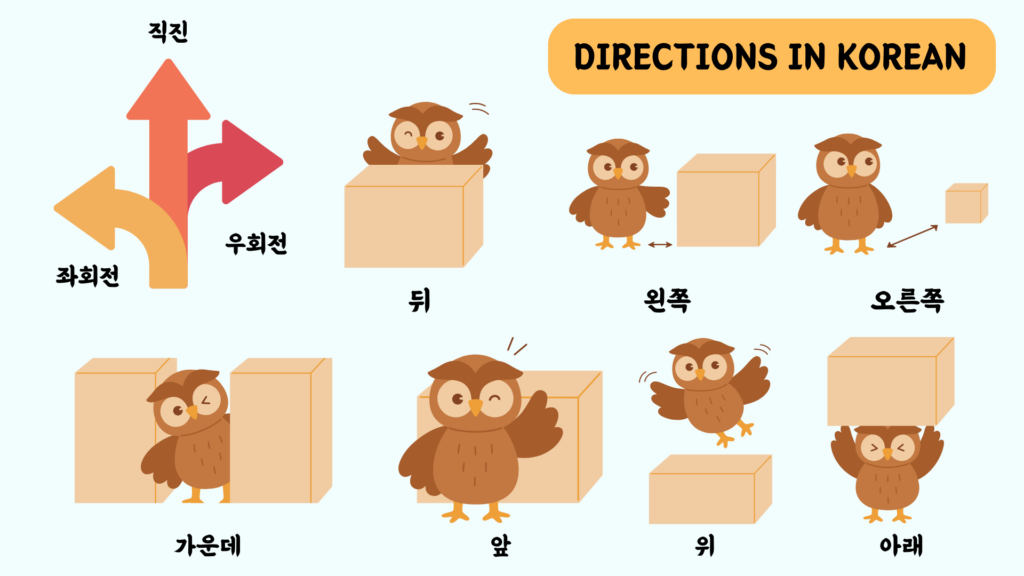
When you’re in Korea, you’ll want to explore many different places. Some are easy to reach, but others might be tricky.
Learning Korean is excellent, but you might not have the time or resources to do so right now. But as you travel around Korea, knowing how to give directions becomes more important.
Today, this blog will teach you all you need to know to make your time in Korea go smoothly!
Basic Vocabulary

East
동(쪽) dong (jjok)

West
서(쪽) seo(jjok)

South
남(쪽) nam(jjok)

North
북(쪽) buk(jjok)

East, west, south and north
동서남북 (dong seo nam buk)
Talking about Directions
[City]은/는 [country]의 [direction]에 위치해있다.
[City] is in the [direction] part of [country].
Example:
부산은 한국의 남쪽에 위치해있다.
Busan is situated in the southern part of Korea.
Positional Terms
Understanding positional terms is helpful for describing where things are located. Words like “above,” “below,” “beside,” and “between” help us explain the position of objects in relation to each other. These terms are useful in everyday conversations, such as when talking about where things are placed in a room or how to find something. Learning positional terms makes it easier to communicate and understand spatial relationships.

Left
왼쪽 (waen jjok)

Right
오른쪽 (o reun jjok)

Above/Top
위 (ui)

Below/Bottom
아래 (a rae)

Front
앞 (ab)

Back/Behind
뒤 (dui)

Beside/Next to
옆 (yeob)

Middle
가운데 (ga un dae)

Inside
안 (an)

Outside
밖 (bag)

Nearby
근처 (geun cho)

Between
사이 (sa yi)
Phrases about Positional Terms

The person on my left is my brother.
제 왼쪽에 있는 사람은 동생이에요. (Jae oenjjoge inneun saram-eun dongsaeng-ieyo)

There is a small garden on the right side of our house.
우리 집의 오른쪽에 작은 정원이 있어요. (uri jibe oreunjjoge jageun jongwoni issoyo)

There is an apple on the desk.
책상 위에 사과가 있어요. (chaeksang wie sagwaga isseoyo)

There is a book under the bed.
침대 아래에 책이 있어요. (chimdae arae-e chaeg-i isseoyo)

I always go to the mart in front of my house.저는 항상 제 집 앞에 있는 마트에 가요. (joneun hangsang je jip ape inneun mateue gayo)

She is standing behind me.
그 여자는 제 뒤에 서 있어요.
(geuyeojaneun jae dwie so issoyo)

I was sitting next to my friend.
나는 친구 옆에 앉아 있었어요. (naneun chingu yope anja issossoyo )

My bag is the one in the middle.
제 가방은 가운데에 있어요.(je gabangeun gaundee issoyo)

It’s raining outside our house.
집 밖에 비가 오고 있어요. (jip bakke biga ogo issoyo)

There is a park near the school.
학교 근처에 공원이 있어요. (jip bakkeso biga ogo issoyo)
Directional Terms
Knowing directional terms is important for giving and understanding directions. Words like “go forward,” “backward,” “upward,” and “to the right” help us know where to go. They’re useful in everyday situations, like telling someone how to find a place or following instructions. Learning these terms helps us navigate easily and communicate clearly, making things simpler for everyone.

Forward
앞으로 (ap eu ro)

Backward
뒤로 (dui ro)

Upward
위로 (wui ro)

Downward
아래로 / 밑으로 (a rae ro / mi teu ro)

To the left
왼쪽으로 (waen jjog eu ro)

To the right
오른쪽으로 (o reun jjog eu ro)

Reverse
후진 (hu jin)

Go straight
직진 (jik jin)

Turn left
좌회전 (jwa hue jeon)

Turn right
우회전 (wu hue jeon)

This way
이쪽 (i jjok)

That way
저쪽 (jeo jjok)
Phrases about Directional Terms

Please go forward.
앞으로 가주세요. (apeuro gajuseyo)

The car reversed backward.
차가 뒤로 후진했어요. (chaga dwiro hujinhaessoyo)

Please hold the picture up.
그림을 위로 들어주세요. (geurimeul wiro deuro juseyo)

Please lower the desk downward.
책상을 아래로 내려주세요. (chaekssangeul araero naeryojuseyo)

Go to the left side of the toilet.
화장실 왼쪽으로 가세요. (hwajangsil waenjjogeuro gaseyo)

Please go to the right.
오른쪽으로 가주세요. (oreunjjogeuro gajuseyo)

Go straight when you get out of the exit.
출구에서 나오면 직진하세요.

Please drop me off after the right turn.
우회전한 다음 내려주세요. (uhwejon hu joreul naeryojuseyo)

Please come this way.
이쪽으로 오세요. (ijjogeuro oseyo)
In conclusion, understanding and effectively communicating directions is crucial in various aspects of life, whether it’s navigating through unfamiliar places, giving instructions, or simply expressing movement. Through this blog, we’ve explored different directional words and commands in Korean, such as “위로” (upward), “아래로” (downward), “왼쪽으로” (to the left), “오른쪽으로” (to the right), “진행” (proceed), “직진” (go straight), “후진” (reverse), “좌회전” (left turn), “우회전” (right turn), “이쪽” (this way), and “저쪽” (that way).
By mastering these directional terms, one can effectively give and receive directions, enhancing communication and navigation skills. Whether you’re traveling, giving instructions in a classroom or workplace, or simply exploring new areas, understanding directional language is essential for clear and effective communication.
Table of Contents

